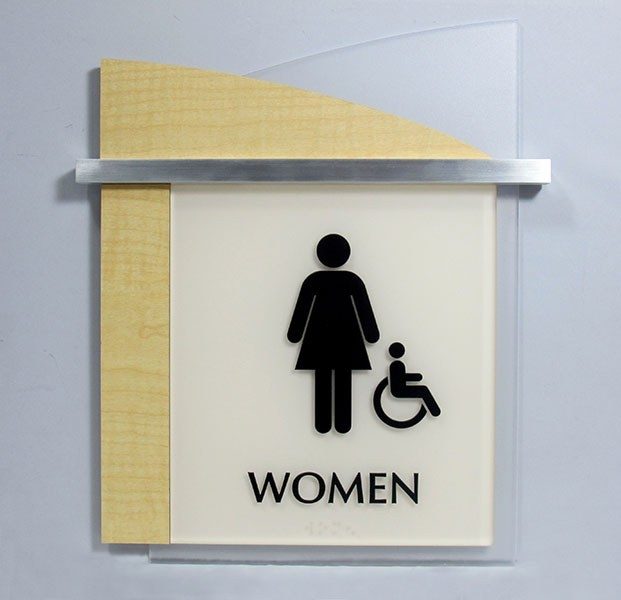ADA Signage: Guaranteeing Availability and Compliance in Public Spaces
ADA signage plays a vital duty in guaranteeing ease of access and compliance within public spaces, dramatically adding to an inclusive environment for individuals with handicaps. By adhering to ADA requirements, signs not just facilitates navigating however likewise emphasizes an organization's devotion to variety and equality. As we check out the subtleties of ADA signs, from responsive features to design details, it's critical to think about just how these elements integrate to support the rights of all individuals. What are the usual pitfalls organizations face in maintaining conformity, and how can future fads in signage proceed to drive availability ahead?
Relevance of ADA Signs
In modern society, the importance of ADA signage extends beyond plain conformity with legal requireds to embody a commitment to inclusivity and access for all individuals. These indicators are necessary in creating atmospheres where people with handicaps can browse public rooms with the exact same simplicity and self-reliance as those without specials needs. By giving clear and standardized information, ADA signage guarantees that every person can access centers, services, and info without obstacles.
The significance of ADA signs depends on its capacity to boost the high quality of life for individuals with impairments by advertising equivalent access. It eliminates the barriers that may otherwise hinder their ability to take part totally in neighborhood life. These indications serve as visible indications of a company's devotion to diversity and equality, showing more comprehensive societal values that champion the rights and self-respect of all individuals.
Furthermore, ADA signs plays an essential function in public safety. By guiding individuals to departures, restrooms, and other crucial facilities, it makes sure that all individuals, despite physical capacity, can leave safely throughout emergencies. In recap, ADA signs is not just a regulative need however an effective device for promoting a fair and inclusive culture.
Secret Elements of Conformity

Placement is important; indications should be set up in locations that are quickly visible and reachable. Usually, signs must be installed between 48 and 60 inches from the ground to make certain access for both standing and wheelchair users. Tactile elements, such as Braille, are crucial for people with aesthetic disabilities, providing important details in a non-visual layout.
High-contrast colors between the message and history are necessary to boost readability for individuals with reduced vision. The ADA mandates specific comparison ratios to ensure clearness. Furthermore, character size is a crucial consideration, with minimum elevation demands determined by the viewing range to guarantee readability from numerous angles.
Style Considerations for Availability
Designing obtainable signage calls for a precise approach to ensure it meets the demands of all customers, especially those with disabilities. This involves considering numerous design components that enhance readability and use. Trick aspects include the option of font style, shade contrast, and responsive attributes. Typefaces should be sans-serif, with clear and easy letterforms, to promote simple reading. The dimension of the message is similarly crucial, with ADA standards advising a minimal elevation based upon viewing distance to guarantee clarity.
Contrasting shades in between text and history are crucial for visibility, specifically for people with visual impairments. A high contrast ratio assists distinguish the text from its background, improving readability under different illumination conditions. In addition, tactile elements, such as Braille and increased personalities, are important for individuals that are blind or have reduced vision. These aspects ought to be situated at a regular elevation and setting to ensure easy accessibility and understanding.
In addition, the placement of signs plays a substantial duty in access. Indicators need to be mounted in places that are Related Site conveniently reachable and unobstructed. Ensuring that signage is installed at proper heights and angles makes it possible for all individuals, including those making use of mobility devices, to interact with them successfully.
Usual Mistakes to Stay Clear Of

An additional common mistake is the wrong positioning of signs. ADA standards specify precise height and place demands to ensure that indications are conveniently noticeable and reachable by all individuals, including those making use of mobility devices. Overlooking these guidelines not just interferes with ease of access but likewise risks non-compliance with legal criteria.
Additionally, inadequate comparison in between text and history is a regular oversight. Ample comparison is vital for readability, especially for people with reduced vision. Designers often pick shades that are aesthetically appealing but lack the required contrast, rendering the message challenging to determine.
Lastly, some developers fail to integrate tactile elements, such as Braille, which are vital for people that are blind. Omitting these functions not only leads to non-compliance with ADA policies yet also limits accessibility for a sector of the populace that depends on tactile information.
Future Trends in Signs
Developments in innovation and boosting understanding of inclusivity are forming the future fads in signage style. As culture comes to be much more conscious of varied needs, the assimilation of clever technologies into signage is obtaining grip. Digital signage, for example, is evolving to include real-time updates and interactive attributes, which can be important in giving vibrant details in public spaces. These indications frequently incorporate touch displays or gesture-based controls, allowing individuals to navigate content tailored to their certain demands.
An additional arising trend is the use of increased truth (AR) to enhance user experience. AR-enabled signs can overlay electronic info onto the physical environment, supplying aesthetically damaged individuals with auditory or haptic responses. ADA Signs. This technology not only enhances availability but also develops an appealing experience for all users
Sustainability is likewise a significant aspect affecting signage trends. Green materials and energy-efficient illumination options are being focused on to line up with global ecological goals. Advancements in products science are leading to the growth of more have a peek here weather-resistant and long lasting signs.
Final Thought
ADA signage plays an essential role in ensuring accessibility and conformity within public rooms by including tactile aspects, high-contrast shades, and strategic positioning. The adherence to ADA criteria not only facilitates risk-free navigation for people with impairments yet likewise indicates an organization's devotion to variety and inclusivity. By avoiding typical blunders and embracing future fads, public spaces can remain to advance these values, making sure that the legal rights and self-respect of all individuals are valued and supported.
ADA signage plays a vital duty in guaranteeing availability and compliance within public areas, considerably adding to an inclusive environment for individuals with handicaps. As we discover the nuances of ADA signs, from responsive attributes to develop intricacies, it's essential to think about how these elements coalesce to maintain the legal rights site web of all individuals.In modern society, the importance of ADA signs expands past simple conformity with lawful requireds to personify a commitment to inclusivity and access for all individuals. By providing standardized and clear info, ADA signage ensures that every person can access facilities, services, and details without obstacles.
ADA signage plays a vital role in ensuring access and compliance within public areas by integrating responsive aspects, high-contrast colors, and strategic placement. (ADA Signs)
 Edward Furlong Then & Now!
Edward Furlong Then & Now! Jason J. Richter Then & Now!
Jason J. Richter Then & Now! Alexa Vega Then & Now!
Alexa Vega Then & Now! Heather Locklear Then & Now!
Heather Locklear Then & Now! Barbara Eden Then & Now!
Barbara Eden Then & Now!